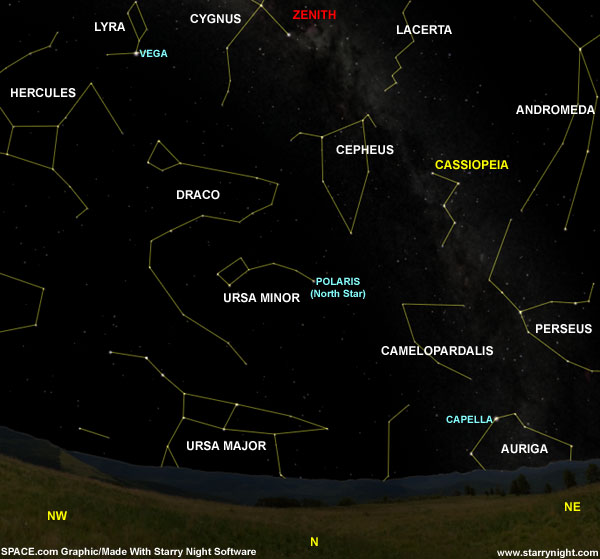Queen of the Sky: An Easy-to-Spot Star Pattern

Riding high in the northeast sky as darkness descends is a striking zigzag row of five stars marking the Queen of Ethiopia, Cassiopeia.
Few star patterns have a shape so easy to remember: a neat "M" or "W" depending upon on its position and which way you face. The Greeks added a nearby additional fainter star to the five main stars, so that the six together outlines Cassiopeia's Chair.
At this time of the year, as Cassiopeia ascends the early evening sky, she actually seems to resemble a sort of crooked number 3. At around 1 a.m. local daylight time, you'll find her nearly overhead, soaring high above Polaris, the North Star and most resembling an "M." At that time, even those living as far south as 20? south latitude (northernmost Chile and northern Australia as examples) can see the Queen, hovering directly above their northern horizon.
Cassiopeia circles in the north opposite to the Big Dipper, and so near to the pole that, like the Dipper, she too, never goes below the horizons of mid-northern latitudes.
Cassiopeia lies almost completely within the Milky Way, embedded in some marvelous star fields. In contrast to the region around Sagittarius (which marks the center of our galaxy), in Cassiopeia we are looking out toward the outer edges of our galaxy.
Nonetheless, there probably isn't a better place to start observing on a clear, crisp autumn night. If you own a pair of binoculars, there is excellent "sweeping" all through this part of the sky.
One object that will immediately catch your attention actually belongs not to Cassiopeia, but to an adjacent pattern of stars that represents her future son-in-law, Perseus. If you extend an imaginary line roughly 1? times the distance from the star Gamma to Delta Cass (also known as Ruchbah) and beyond, you'll come across a faint blur of light which binoculars will readily reveal as two magnificent clusters of stars.
Breaking space news, the latest updates on rocket launches, skywatching events and more!
An even more beautiful spectacle awaits you with a small telescope with low power. Popularly known simply as "The Double Cluster" it is indeed, one of the most brilliant telescopic sights in the sky.
There are other fine clusters of stars intermingled within Cassiopeia. Concentrate especially on that area between Ruchbah and Epsilon Cass for a beautiful field of stars, which includes the galactic star cluster M103 as well as a couple of nearby smaller clusters.
Look also for an extremely rich swarm of faint stars not too far to the west of Caph, known as NGC 7789. Discovered in 1783 by William Herschel's sister Caroline, it has been described as appearing like a large cloud of small stars on a ground of stardust. In his classic observing handbook "Cycle of Celestial Objects," Admiral William H. Smyth (1788-1865) called it "a vast region of inexpressible splendor."
From descriptions such as these, it is obvious that you'll certainly enjoy exploring the region around Cassiopeia on dark nights. An amazing profusion of celestial treasures awaits you. Such treasures indeed seem especially fitting for a Queen!
- Total Lunar Eclipse Coming Oct. 27
- Sky Calendar: What's Up Tonight
- 10 Steps to Rewarding Stargazing
- The 10 Brightest Stars
Joe Rao serves as an instructor and guest lecturer at New York's Hayden Planetarium. He writes about astronomy for The New York Times and other publications, and he is also an on-camera meteorologist for News 12 Westchester, New York.

Joe Rao is Space.com's skywatching columnist, as well as a veteran meteorologist and eclipse chaser who also serves as an instructor and guest lecturer at New York's Hayden Planetarium. He writes about astronomy for Natural History magazine, Sky & Telescope and other publications. Joe is an 8-time Emmy-nominated meteorologist who served the Putnam Valley region of New York for over 21 years. You can find him on Twitter and YouTube tracking lunar and solar eclipses, meteor showers and more. To find out Joe's latest project, visit him on Twitter.
